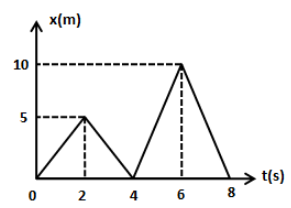
The position-time (x-t) graph for a particle moving along x-axis is as shown. Average speed of the particle between \[t = 0\] and \[t = 8\,{\text{s}}\] is

A. Zero
B. 8 m/s
C. 3.75 m/s
D. 4.25 m/s

Answer
543.6k+ views
Hint:The average speed of the particle is the ratio of total distance travelled to the total time taken. The total distance travelled by the particle is the area under the curve of the above figure. The area under the curve consists of two triangles as shown in the above figure.
Formula used:
Average speed, \[{v_{avg}} = \dfrac{D}{t}\]
Here, D is the total distance and t is the total elapsed time.
Complete step by step answer:
We know that the average speed of the particle is the ratio of total distance travelled to the total time taken.
\[{v_{avg}} = \dfrac{D}{t}\]
Here, D is the total distance and t is the total elapsed time.
In the above figure, the total distance travelled by the particle can be calculated by determining the area under the curve. We can see the area under the curve has two triangles of the same base length and different height.
The area under the curve is,
\[D = A = \dfrac{1}{2}\left( {4 \times 5} \right) + \dfrac{1}{2}\left( {4 \times 10} \right)\]
\[ \Rightarrow D = 10 + 20\]
\[ \Rightarrow D = 30\,{\text{m}}\]
Now, the average speed of the particle is,
\[{v_{avg}} = \dfrac{D}{t}\]
Substituting \[D = 30\,{\text{m}}\] and \[t = 8\,{\text{s}}\] in the above equation, we get,
\[{v_{avg}} = \dfrac{{30}}{8}\]
\[ \therefore {v_{avg}} = 3.75\,{\text{m/s}}\]
Therefore, the average speed of the particle between \[t = 0\] and \[t = 8\,{\text{s}}\] is 3.75 m/s.
So, the correct answer is option C.
Note: If you are asked to determine the average velocity of the particle from the given distance-time graph, then the average velocity is zero because the initial and final position of the particle is the same. The average velocity deals with displacement of the particle while the average speed deals with total distance travelled by the particle. Note that the area under the curve is not the average speed of the particle.
Formula used:
Average speed, \[{v_{avg}} = \dfrac{D}{t}\]
Here, D is the total distance and t is the total elapsed time.
Complete step by step answer:
We know that the average speed of the particle is the ratio of total distance travelled to the total time taken.
\[{v_{avg}} = \dfrac{D}{t}\]
Here, D is the total distance and t is the total elapsed time.
In the above figure, the total distance travelled by the particle can be calculated by determining the area under the curve. We can see the area under the curve has two triangles of the same base length and different height.
The area under the curve is,
\[D = A = \dfrac{1}{2}\left( {4 \times 5} \right) + \dfrac{1}{2}\left( {4 \times 10} \right)\]
\[ \Rightarrow D = 10 + 20\]
\[ \Rightarrow D = 30\,{\text{m}}\]
Now, the average speed of the particle is,
\[{v_{avg}} = \dfrac{D}{t}\]
Substituting \[D = 30\,{\text{m}}\] and \[t = 8\,{\text{s}}\] in the above equation, we get,
\[{v_{avg}} = \dfrac{{30}}{8}\]
\[ \therefore {v_{avg}} = 3.75\,{\text{m/s}}\]
Therefore, the average speed of the particle between \[t = 0\] and \[t = 8\,{\text{s}}\] is 3.75 m/s.
So, the correct answer is option C.
Note: If you are asked to determine the average velocity of the particle from the given distance-time graph, then the average velocity is zero because the initial and final position of the particle is the same. The average velocity deals with displacement of the particle while the average speed deals with total distance travelled by the particle. Note that the area under the curve is not the average speed of the particle.
Recently Updated Pages
Master Class 12 Economics: Engaging Questions & Answers for Success

Master Class 12 Maths: Engaging Questions & Answers for Success

Master Class 12 Biology: Engaging Questions & Answers for Success

Master Class 12 Physics: Engaging Questions & Answers for Success

Master Class 8 Maths: Engaging Questions & Answers for Success

Class 8 Question and Answer - Your Ultimate Solutions Guide

Trending doubts
Which animal has three hearts class 11 biology CBSE

1 Quintal is equal to a 110 kg b 10 kg c 100kg d 1000 class 11 physics CBSE

Explain zero factorial class 11 maths CBSE

Mention the basic forces in nature class 11 physics CBSE

What is centripetal acceleration Derive the expression class 11 physics CBSE

Bond order ofO2 O2+ O2 and O22 is in order A O2 langle class 11 chemistry CBSE




